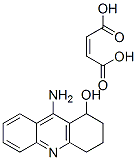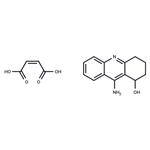Velnacrine maleate SM 10.888,Hoechst-Roussel (Aventis) Sumitimo JPN
A potential Alzheimer's Disease therapeutic of low toxicity. Exhibits biochemical and pharmacological profile similar to THA except that it is far less toxic and without measurable liver toxicity in humans.
A potential Alzheimer Disease therapeutic of low toxicity. Exhibits biochemical and pharmacological profile similar to THA except that it is far less toxic and without measurable liver toxicity in humans
Cholinesterase inhibitor. Potential Alzheimer's disease therapeutic
In 100 ml of tetrahydrofuran was added 5.00 g of 9-amino-3,4-dihydroacridin-
1(2)-one. The mechanically stirred suspension was cooled to -5°C and 21.4 ml
(1 eq.) of 1.1 M LiAlH 4 solution in ether was added dropwise. After completion
of the addition, the reaction mixture was stirred further for 2 hours,
whereupon the reaction complete based on thin chromatography analysis. The
LiAlH 4 was neutralized with 2 ml of saturated NH 4 Cl and the salts were
dissolved with 30% potassium hydroxide. The insoluble product was filtered
off and rinsed with water. The precipitate was then dissolved in 3 N
hydrochloric acid and the residual insoluble salts filtered off. The acid solution
washed with ethyl acetate and made basic (pH 9) with 10% sodium
hydroxide. The precipitated product was filtered and washed with water. After
drying at 80°C under vacuum overnight, 4.15 g (82%) of (+/-)-9-amino-
1,2,3,4-tetrahydro-1-acridinol was obtained, melting point 245°C. (+/-)-9-
Amino-1,2,3,4-tetrahydro-1-acridinol maleate has melting point 171-173°C.
Mentane (Hoechst-Roussel).
Cholinesterase inhibitor, Cognition activator
hydroxytacrine maleate, a bioactive monohydroxylated metabolite of cholinesterase inhibitor, is a potential alzheimer's therapeutic of low toxicity [1]. hydroxytacrine maleate exhibited biochemical and pharmacological profile similar to tacrine (tha) except that the far less liver toxicity in humans. the prolonged use of tacrine has been associated with liver toxicity[1, 2].hydroxytacrine maleate is a parasympathomimetic and a centrally acting cholinesterase inhibitor (anticholinesterase). as the first cholinesterase inhibitor approved for the treatment of ad, tacrine was marketed under the trade name cognex [3]. through hydroxylation of benzylic carbon by cyp450 in the liver, tacrine has been metabolized into metabolite 1-hydroxy-tacrine (velnacrine) [4]. it has also been shown that maleate is an inhibitor of ache [5].
[1]. d. muoz-torrero. acetylcholinesterase inhibitors as disease-modifying therapies for alzheimer’s disease. curr. med. chem. 15, 2433-2455 (2008).
[2]. e. giacobini. cholinesterase inhibitors for alzheimer’s disease therapy: from tacrine to future applications. neurochemistry international 32, 413-419(1998).
[3]. birks j s. cholinesterase inhibitors for alzheimer's disease[j]. the cochrane library, 2006.
[4]. peng j z, remmel r p, sawchuk r j. inhibition of murine cytochrome p4501a by tacrine: in vitro studies[j]. drug metabolism and disposition, 2004, 32(8): 805-812.
[5]. acetylcholine and choline effects on erythrocyte nitrite and nitrate levels.

